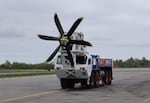Alaska Airlines ceremonially handed over a surplus turboprop airliner on Monday to a company that aims to turn it into the largest hydrogen-powered plane yet to fly.
The event at Paine Field in Everett, Washington, attracted prominent politicians and a throng of students interested in aviation in a sign of the current buzz around hydrogen fuel as a means to decarbonize air travel.
Alaska Airlines CEO Ben Minicucci made a show of handing the keys of a retired Bombardier Q400 turboprop airliner to ZeroAvia CEO Val Miftakhov.
"Val, you go crazy. Make this thing happen," Minicucci said to Miftakhov. "To have a front row seat at revolutionizing the way propulsion evolves is pretty cool."
Earlier this year, Alaska Airlines replaced the last of its Q400 turboprops with regional jets. The surplus twin-engine, 76-seaters are now for sale except for the one given a fresh paint job before its transfer to partner ZeroAvia.
"Years from now, you will look back and say this is the time when the transformation of real, large aircraft — real commercial aircraft — started," Miftakhov said when it was his turn to address the audience.
Speaking with reporters later, Miftakhov estimated it would take about five years for the large, propeller-driven airliner class to be ready to fly commercially with retrofitted zero-emission power. ZeroAvia is first targeting to sell hydrogen-electric propulsion systems for 10-20 seat aircraft, which it hopes to have government certified in about two years.
Alaska Airlines Senior VP for Sustainability Diana Birkett Rakow hesitated to predict whether her carrier's regional unit, Horizon Air, would revert to propeller aircraft after just having made a transition to an all-jet fleet.
"We are using this as a perfect size to demonstrate this technology and move this technology toward certification," Birkett Rakow said in the shadow of the future hydrogen plane. "The idea is let's prove that we can do this at a larger scale for regional aircraft, for regional fleets across the world hopefully, and then continue to expand from there."

Politicians and corporate leaders gathered in a Paine Field hangar to celebrate the handover of a retired Alaska Airlines Q400 turboprop, which will be converted to hydrogen-electric propulsion over the next year.
Tom Banse / NW News Network
Alaska Airlines and ZeroAvia said the retrofitted Q400 would become the world's largest zero-emission aircraft when it makes its first test flight next year. One of its two motors will be powered by hydrogen fuel cells while the other will run on regular jet fuel just to be safe. Currently, the honor of largest belongs to a competitor named Universal Hydrogen, which performed the first flight of a retrofitted 50-passenger De Havilland Dash 8-300 at Moses Lake, Washington, on March 2, 2023. That test flight leap-frogged ZeroAvia's maiden flight just this past January with a 19-seat Dornier 228 regional airliner converted to hydrogen power in England.
Another green aircraft company, Arlington, Washington-based Eviation, conducted a successful test flight at Moses Lake of an all-electric commuter plane in September 2022. The 9-passenger Eviation Alice model is battery powered.
On stage at Paine Field on Monday, Washington Gov. Jay Inslee, Congresswoman Suzan DelBene (D-WA) and Snohomish County Executive Dave Somers reveled in how their home state was becoming a center of greener air travel innovations.
“To be able to see the future right now in this airplane, nothing could be more exciting," Inslee said.
Inslee said Washington state awarded a $350,000 economic development grant last year to help attract the ZeroAvia hydrogen airplane development project to Paine Field. The Anglo-American startup with headquarters in California has assigned dozens of aerospace engineers and mechanics to electrify the propulsion system in the Q400 prototype and install hydrogen tanks and fuel cells. Pacific Northwest investors in ZeroAvia include Alaska Airlines, Amazon and one of Bill Gates’ venture capital funds.
Airlines such as United, American and Alaska are placing multiple bets on what will power climate-friendly aviation in the future. Recent purchase commitments and partnership signings point to biofuels being likely to go mainstream for large commercial airliners sooner than hydrogen-electric motors.
Aerospace analysts have identified numerous issues that hydrogen propulsion needs to overcome to become economically viable in aviation. One is the cost of building all-new fueling infrastructure at airports. Another hitch is that compressed gaseous hydrogen takes up more room in an airplane fuselage than regular jet fuel. Initially, that has necessitated the removal of valuable seats in the rear of the aircraft mockups and settling for shorter range.
Rep. DelBene said regional clean “hydrogen hubs” to be seeded with up to $1.2 billion each in U.S. Department of Energy funding could help build out the hydrogen supply chain and infrastructure. Washington state and Oregon recently submitted a joint proposal for hydrogen hub funding. The bi-state proposal cited the aviation sector as one of several possible end users in a new hydrogen production economy.

The aircraft handover ceremony also included a surprisingly quiet demonstration of the ground-test rig and a prototype electric motor of the type to be retrofitted onto the hydrogen-electric Q400 airliner.
Tom Banse / NW News Network